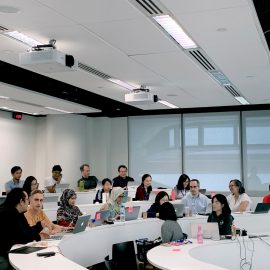

This article is an excerpt from the Shortform book guide to "Linchpin" by Seth Godin. Shortform has the world's best summaries and analyses of books you should be reading.
Like this article? Sign up for a free trial here.
Why is it increasingly harder to find career security? Which jobs offer the most career security?
In Linchpin, Seth Godin argues that becoming a “linchpin” employee—a person with uniquely indispensable skills in an organization—is necessary for career security in today’s tumultuous job market. He further claims that it’s becoming increasingly difficult to earn a living with a non-linchpin job.
Read on to learn more about linchpin jobs and why they offer career security, according to Godin.
Is Career Security Declining?
Entrepreneur and leadership expert Seth Godin states that from the Industrial Revolution to the present day, people could earn a comfortable, stable living by doing nothing but following directions. Factories built for mass production offered career security by paying workers a steady income to do simple, repetitive tasks—for example, installing television screens on an assembly line. Similarly, companies paid office workers to do nothing but follow instructions, like an IT specialist who fixes the office’s computers by following a manual.
Unfortunately, Godin explains that as the 21st century progresses, it’s becoming increasingly difficult to establish career security by following directions. As corporations have developed, they’ve built and honed internal systems in which workers can be productive by following simple directions that are difficult to get wrong. This means that steadily, jobs have become more streamlined and workers need less experience and skill to perform them, enabling employers to pay their employees less and replace them more easily. On top of this, technological advancements and the rise of the Internet have made it easier than ever for companies to automate tasks and outsource labor to those around the world who will work for less pay.
Linchpin vs. Non-Linchpin Jobs
Godin uses the word “linchpin” to describe employees working in jobs where their organizations depend on them so much that they hold the operation together (like a physical linchpin holds together wheels and axles). In contrast, Godin classifies “non-linchpin” employees as those working in jobs that only require them to follow directions, as we discussed previously.
| Are Non-Linchpin Jobs Really Obsolete? In Thank You for Being Late, Thomas Friedman also chronicles the disappearance of low-skill factory and office jobs in the 21st century. However, he would likely argue that Godin is exaggerating the death of the well-paying non-linchpin job. Whereas Godin claims that well-paying jobs in which you just follow directions are disappearing, Friedman argues that these jobs are still available and profitable—you just need more education and greater skills to claim them. Godin asserts that corporations have built infrastructures that enable any low-skill individual to do jobs that previously required higher skills, devaluing high-skill non-linchpin workers. However, Friedman argues that technology has advanced so quickly that new high-skill jobs have risen to replace those of the past, and thus companies are still in desperate need of high-skill, non-linchpin workers. For example, if you know how to operate and monitor AI-assisted crop-pollinating robot bees, you don’t need to be particularly passionate or innovative at work to have career security—the technology is so new that very few people know how to do your job. Presumably, since Friedman believes there are more high-skill jobs available than people to fill them, he likely doesn’t see globalization as a significant threat to the workforce. Additionally, Friedman doesn’t think automation is as much of a threat as Godin does. He cites economic research indicating that the increase in productivity from automation will increase consumer demand enough that the number of available jobs may actually increase. His main concern is that we need to make sure workers receive enough high-skill training to fill these new jobs. |
Today’s Economy Demands Linchpins
While jobs that only require you to follow directions pay lower wages and are less secure than they were in the past, Godin argues that, in contrast, linchpin jobs are in high demand, yielding higher wages and career security.
Godin claims that nowadays, it’s impossible to compete with the biggest corporations unless you build your business around linchpins. Nearly every industry is saturated with countless businesses that are all trying to do the same thing: offer goods and services that are fast, cheap, and meet minimum customer expectations. Because everyone is competing to offer the lowest prices and the quickest, most convenient transactions, it’s essentially impossible for most businesses to succeed by aiming for these same goals. Your local bookstore can’t afford to offer books cheaper than Barnes & Noble, and it doesn’t have a convenient online shipping system like the larger corporation.
With this in mind, the most reliable way for businesses to succeed is to aim for different goals: Offer high-quality goods and services that exceed customer expectations in dazzling new ways.
| How Godin’s Linchpin Theory Applies to Businesses Purple Cow, which Godin wrote seven years before Linchpin, covers many of these same ideas; however, it’s intended for small business owners seeking a competitive advantage rather than employees seeking job security. The thesis of Purple Cow is that markets are so saturated with corporations selling cheap, convenient goods that the only reliable way to start a profitable business is to offer customers something exciting and new—a “purple cow” in a field of brown cows. To come up with an idea for such a business, identify one quality of your product that you can push to the extreme. For example, IKEA chose to put more effort into its designs than any of its competitors, making it the most aesthetically pleasing budget furniture brand on the market. Consequently, they quickly claimed a dominant market position worldwide. One main reason linchpins are valuable is that they help organizations reach these extremes by innovating more than other employees (as we’ll see next). Once you have a remarkable product, you must market it to risk-taking innovators rather than a general audience. The small segment of customers on the lookout for something new is more valuable than anyone else because they spread the word about your product to the rest of the world. Additionally, since they’re passionate about your innovative product, they spend more money than typical customers. |

———End of Preview———
Like what you just read? Read the rest of the world's best book summary and analysis of Seth Godin's "Linchpin" at Shortform.
Here's what you'll find in our full Linchpin summary:
- Why you must become a "linchpin" if you want to create work that changes the world
- The steps you can take to become a linchpin
- How bosses can nurture and manage linchpin employees






